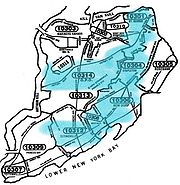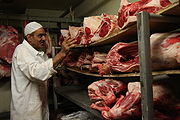From The Peopling of New York City
Contents |
Overview
The Egyptian community on Staten Island makes up .45% of the borough's total population. Relatively speaking, Egyptians are most concentrated in the Castleton Corners-New Springville area (zip code 10314), with the Eltingville-Arden Heights area (10312) in a close second and others peppered mainly around Stapleton-Todt Hill (10304), New Brighton-Grymes Hill (10301), and New Dorp-Richmondtown (10306).
Demographics
The total population of Egyptians is hard to estimate in 1990, since the census only gives data for people of Arab descent. Further research shows that about 12% of all Arabs are Egyptians. We can take from this the estimate that the total population of Egyptians is around 346. We can see that the population skyrocketed in 10 years, from 346 to 1981 (about 6 times as much). We can even see this through the census results. While it was deemed unnecessary to tally Egyptians in 1990, in 2000 they gained their own category. Unfortunately, the ACS gives a 0 for the tally of Egyptians in 2005 and 2006. In fact, it gives a 0 for all other communities. Of course, it’s not that there are suddenly 0 people identifying with foreign communities in 5 years, but rather that it was deemed unnecessary to give a record of the people here.
History
The reasons for Middle Eastern/ Egyptian immigration are varied. A major cause was simply a desire to attain a better quality of life, with more social and economic freedom and opportunities. In certain regions, war and corruption were very prevalent, leaving many with no choice but to escape. In the 1950's, leaders like King Farouk were abusive towards Egyptian citizens, and his reign was succeeded by Gamal Abdel Nasser, a corrupt leader who stated, for example, that Jews owned everything and had all the power in Egypt, starting a war. In addition to this, the Suez Canal War was taking place. During this time, United States soldiers were actually deployed in Egypt in order to help citizens in need due to the horrible living conditions many were facing. Middle Eastern people, upon arriving in the United States, had a tendency like most other ethnic groups to band together and form small communities.
The People
Ethnic Stages
"Ethnic Stages" refers to the locations on Staten Island or within the community on which people display their community membership and identity. This can mean churches, community centers, specialized stores with products from the home country, restaurants that serve the community's cuisine, or other sorts of institutions.
For the Egyptian community, a major ethnic stage is just over the Verrazano Bridge. The Tanoreen Restaurant, owned by Rawia Bishara, offers authentic Middle Eastern and Arabic cuisine to people in the heart of Bay Ridge. Middle Eastern dishes usually have parsley all around the edges, in order to show sophistication and class. A majority of dishes were cooked with lamb, lemon, eggplant, and pine nuts (traditional foods in their culture); however, they also offered "American" alternatives such as chicken cutlet sandwiches.

